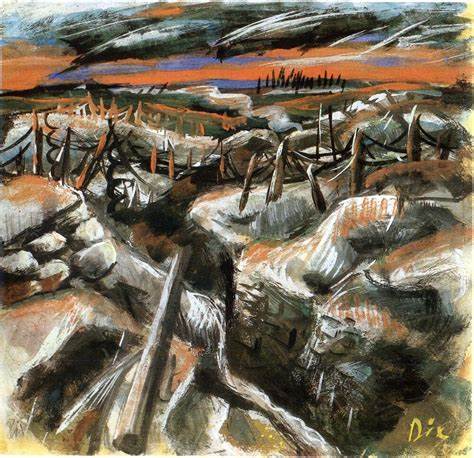And so, when Europe went to war in July in 1914,few ordinary people questioned the prevailing view of Western civilisation as sophisticated, rational and humane.
于是 當(dāng)歐洲在1914年7月開(kāi)戰(zhàn)的時(shí)候 普通人鮮少質(zhì)疑 西方文明是成熟 理性且人性的這一普遍觀點(diǎn)
Yet the horror that was unleashed by new weapons that could slaughter human beings on an unprecedented scale
而那些能夠致使人類(lèi)遭受 史無(wú)前例規(guī)模毀滅的新武器所造成的恐慌
was a product of the same Industrial Revolution that had forged the railways and built the Eiffel Tower.
和鐵路與埃菲爾鐵塔 卻都是同一場(chǎng)工業(yè)革命的產(chǎn)物

Now it seemed Europeans were reduced to the same irrational barbarism...
似乎歐洲人已經(jīng)墮落成 同樣的無(wú)理野蠻狀態(tài)了
..that they'd convinced themselves was the hallmark of other, supposedly primitive, peoples.
而他們?cè)_信這種狀態(tài)僅僅是其他那些 所謂原始民族才具有的特質(zhì)
In the German trenches of the First World War was an artist who perhaps more than any other created a graphic visual record of the new barbarism.
在第一次世界大戰(zhàn)的德軍戰(zhàn)壕中 出現(xiàn)了一位或許比其他任何人都更深刻地 用畫(huà)作對(duì)這一新野蠻狀態(tài)進(jìn)行記錄的藝術(shù)家
Otto Dix was one of the millions of young European men who enthusiastically rushed to enlist at the outbreak of fighting in 1914,
1914年一戰(zhàn)爆發(fā)時(shí) 奧托·迪克斯是 數(shù)百萬(wàn)名熱忱地應(yīng)征入伍的歐洲男青年中的其中一位
and he went on to spend three years in the mud and the slime of the trenches,serving on both the Western and the Eastern fronts.
他隨后又繼續(xù)在戰(zhàn)壕的爛泥渾水中待了三年時(shí)間 在西線(xiàn)和東線(xiàn)都參過(guò)戰(zhàn)
At one point, he served in a machine gun unit,wielding the ultimate industrial weapon,the literal fusion of the gun and the machine.
有一段時(shí)間 他在一支機(jī)槍部隊(duì)里服役 使用的是終極工業(yè)武器 名副其實(shí)的槍與機(jī)器的融合
And throughout all of this,Otto Dix produced sketches, hundreds of them,that graphically recorded what these new weapons did to the flesh and the bone of his doomed generation.
在整個(gè)服役期間 奧托·迪克斯創(chuàng)作了數(shù)百幅作品 它們以圖畫(huà)的形式記錄了這些新型武器對(duì)他這不幸的一代人造成了哪些深入骨髓的傷害
Dix drew the broken faces, the mud and the misery.
迪克斯描繪了那些破損的臉龐 污泥和痛苦
He chronicled how industrial warfare had transformed the soldier from warrior to victim.
他記錄下了工業(yè)戰(zhàn)爭(zhēng)是如何將一位士兵從勇士轉(zhuǎn)變成受害者的
It is perhaps fitting that it was a German artist who most clearly captured the horror of industrial warfare.
或許 也只有德國(guó)藝術(shù)家才能最清晰地記錄工業(yè)戰(zhàn)爭(zhēng)的可怕











